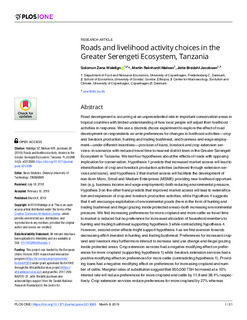| dc.contributor.author | Walelign, Solomon Zena | |
| dc.contributor.author | Nielsen, Martin Reinhardt | |
| dc.contributor.author | Jacobsen, Jette Bredhal | |
| dc.date.accessioned | 2019-09-25T16:57:07Z | |
| dc.date.available | 2019-09-25T16:57:07Z | |
| dc.date.created | 2019-03-30T18:27:38Z | |
| dc.date.issued | 2019 | |
| dc.identifier.citation | PLOS ONE. 2019, 14 (3), . | nb_NO |
| dc.identifier.issn | 1932-6203 | |
| dc.identifier.uri | http://hdl.handle.net/11250/2618834 | |
| dc.description.abstract | Road development is occurring at an unprecedented rate in important conservation areas in tropical countries with limited understanding of how local people will adjust their livelihood activities in response. We use a discrete choice experiment to explore the effect of road development on respondents ex-ante preferences for changes in livelihood activities—crop and livestock production, hunting and trading bushmeat, and business and wage employment—under different incentives—provision of loans, livestock and crop extension services–in scenarios with reduced travel time to nearest district town in the Greater Serengeti Ecosystem in Tanzania. We test four hypotheses about the effects of roads with opposing implication for conservation. Hypothesis 1 predicts that increased market access will lead to intensification of crop and livestock production activities (achieved through extension services and loans), and Hypothesis 2 that market access will facilitate the development of non-farm Micro, Small and Medium Enterprises (MSME) providing new livelihood opportunities (e.g. business income and wage employment)–both reducing environmental pressure. Hypotheis 3 on the other hand predicts that improved market access will lead to extensification and expansion of crop and livestock production activities, while Hypotheis 4 suggests that it will encourage exploitation of environmental goods (here in the form of hunting and trading bushmeat and illegal grazing inside protected areas)–both increasing environmental pressure. We find increasing preferences for more cropland and more cattle as travel time to market is reduced but no preference for increased allocation of household members to hunting and trading bushmeat supporting hypothesis 3 while contradicting hypothesis 4. However, second-order effects might support hypothesis 4 as we find aversion towards decreasing effort invested in hunting and trading bushmeat. Preferences for increased cropland and livestock may furthermore interact to increase land use change and illegal grazing inside protected areas. Crop extension services had a negative modifying effect on preferences for more cropland (supporting hypothesis 1) while livestock extension services had a positive modifying effect on preferences for more cattle (contradicting hypothesis 1). Providing loans had a negative modifying effect on preferences for increasing cropland and number of cattle. Marginal rates of substitution suggest that 950,000 TSH borrowed at a 10% interest rate will reduce preferences for more cropland and cattle by 11.8 and 38.4% respectively. Crop extension services reduce preferences for more cropland by 27% whereas livestock extension services increase preferences for more cattle by 104%. Contradicting Hypothesis 2, we found no preference for increasing the number of households members engaged in business and wage employment in response to reduced travel time. Targeted efforts to increase the educational level as well as entrepreneurship skills in the GSE could promote engagement in the labour market and development of business enterprises diverting focus from traditional activities such as farming and livestock production and hence reducing pressure on the ecosystem. | nb_NO |
| dc.language.iso | eng | nb_NO |
| dc.publisher | Public Library of Science | nb_NO |
| dc.rights | Navngivelse 4.0 Internasjonal | * |
| dc.rights.uri | http://creativecommons.org/licenses/by/4.0/deed.no | * |
| dc.title | Roads and livelihood activity choices in the Greater Serengeti Ecosystem, Tanzania | nb_NO |
| dc.type | Journal article | nb_NO |
| dc.type | Peer reviewed | nb_NO |
| dc.description.version | publishedVersion | nb_NO |
| dc.source.pagenumber | 21 | nb_NO |
| dc.source.volume | 14 | nb_NO |
| dc.source.journal | PLOS ONE | nb_NO |
| dc.source.issue | 3 | nb_NO |
| dc.identifier.doi | 10.1371/journal.pone.0213089 | |
| dc.identifier.cristin | 1689146 | |
| dc.description.localcode | © 2019 Walelign et al. This is an open access article distributed under the terms of the Creative Commons Attribution License, which permits unrestricted use, distribution, and reproduction in any medium, provided the original author and source are credited. | nb_NO |
| cristin.unitcode | 194,67,10,0 | |
| cristin.unitname | Institutt for geografi | |
| cristin.ispublished | true | |
| cristin.fulltext | original | |
| cristin.qualitycode | 1 | |

